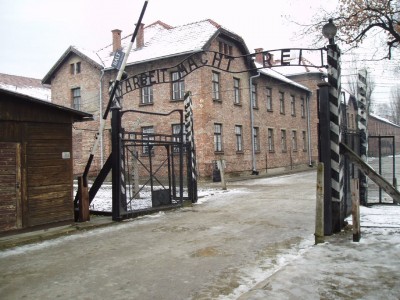First photo on the left was taken shortly before the WWII began, it was maybe 1939.
Second photo is taken, I would say in 1953.
On the first photo there are 6 persons, no one is alive today. Bald man on the right was my grand-grand-father, shot by the Germans in the prison camp. He had red hair. Then, next to him are: his wife and two daughters (his wife is woman with a big belly, daughters are the slim ones, and they both had red hair, which I proudly have too). And then, swarthy man is my grandfather. Next to him is my grandmother, daughter of my grand-grand-father. Kid on the left was my grandmother’s brother – he would become famous car maker and mechanical engineer. I found this photo striking, because it kind-of shows, a groom and his to be bride in the spring, when everything is blooming and life is rushing. You can feel that weather was nice, and like they say “Love is in the air”.

Second photo is taken probably in 1953.
It was taken when a lot of things had happened, some I know from the stories they’ve told me.
On that photo, there is that swarthy man with his — now wife and two kids. During the whole time of the war (1941-1945), he was in the prison camps in Germany.
My grandfather, as the soldier of the King’s Army, was taken to Germany to the camps, and that is what is “Statement of two witnesses” about.
So-called – “Statement of two witnesses” proves that my grandfather was during the war time in the prison camps in Germany: Lübeck, Nürnberg, Hammelburg and Hohenfels.
I also found 38 different papers — Goverment decisions, which were about his job displacements. He traveled to the different cities, worked there as they decide. He was not with his wife. So, during the war, and later, he couldn’t be with her. He had University diploma, and she was a teacher. She had a job and lived in a small town with her kids, and he was sent from one place to the other. With no complaints. Because, he was under suspicion that he might be Russian spy as the intellectual before war. Many of his friends finished on Goli otok (that was a camp made in Yugoslavia for political prisoners).
And the love story…
Love story between my grandfather and his wife. I know about his rage, he pulled her red hair, strands of red hair were on the floor. Tears and that happened before the second photo.
And my grandfather never beat anyone, he was kind man. I remember that he used to go for a walks. He had his thoughts, I could call him for years, I couldn’t reach him. He was so deeply thinking about something, like he was on another planet.
I know that they moved from that town to another; he fell in love with a river Una; went on a fishing regularly, spent a fortune on his hooks and fishing equipment.
I have all those hooks and stuff. And, I am also trying to rectify some “injustice” that life places in front of us.

